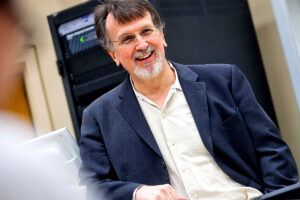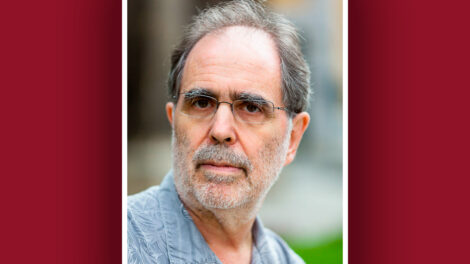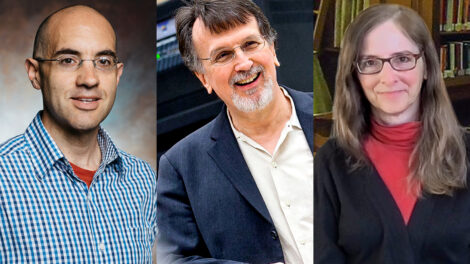Prof. Anthony Cummings’ new book reveals golden age of Florentine music
By Bryan Hay
Visitors to Florence, Italy, are immediately drawn into the ancient city’s tradition of visual art, literature, and science.
In his newly released book, Music in Golden-Age Florence, 1250–1750 (University of Chicago Press), Prof. Anthony Cummings has fulfilled a long-held desire to tell the largely untold story of Florence’s equally rich musical heritage, which helped burnish the Tuscan capital’s reputation as the cradle of the Renaissance as much as the contributions of Michelangelo, Dante, and Galileo.

Prof. Anthony Cummings
Cummings, Eugene H. Clapp II ’36 and Maud Millicent Clapp Professor of Music, presents for the first time a definitive examination of three pivotal musical innovations spawned in Florence during this 500-year span from the late Middle Ages until the end of the Medici dynasty in the mid-18th century: the madrigal, the pianoforte, and opera.
“I just had the sense that our knowledge of the other great Florentine accomplishments was so great that they overwhelmed our knowledge of these great musical developments,” he says. “I thought it was important to tell the whole story of Florentine music and what I call its golden age, to contextualize those three developments.”
Aware of the many fragmentary articles and books on Florentine music, including his own, Cummings, an early music specialist, saw a need for a comprehensive story to be told.
“I thought it was time that somebody stepped back and tried to make sense of all of it and put it into this broader chronological context,” he says.
 Cummings scoured secondary and primary sources for his research, not wanting to miss any detail that would inform readers throughout his book’s 500 pages, which include eight beautiful color illustrations.
Cummings scoured secondary and primary sources for his research, not wanting to miss any detail that would inform readers throughout his book’s 500 pages, which include eight beautiful color illustrations.
Also a devotee of early jazz, he found many previously unknown facts about the music of Florence, similar to what he discovered as he researched New Orleans jazz when he served as dean at Tulane University.
“People think that the story of jazz in New Orleans ends after that early phase, and yet there’s a continuous jazz tradition that carries right through to this day,” he says. “It’s the same with opera. People think that after opera begins in Florence around 1600, the Florentine operatic tradition is no longer quite as vital and important. But it is; they continue to perform celebrated operas. There are very important operas that were performed at the end of the 17th century and in the early 18th century.”
Cummings is already working with harpsichordist and Baroque music specialist Lewis Baratz, who conducts the Lafayette Chamber Orchestra, on companion articles about previously unknown and unpublished arias by Scarlatti and Bononcini, with the goal of having the music published.
There’s a relationship between opera and the madrigal, which also was developed in Florence, he adds.
“Madrigals attempted to express the meaning of the text in a way that reached you emotionally,” says Cummings, noting that the earliest Florentine madrigals, performed by a solo quartet between the acts of plays, were less complex than the later ones that become densely polyphonic.
“And that emotional connection, of course, is central to opera. There is a relationship there,” he adds.
Once the Florentines demonstrated the virtues of opera, the musical form moved quickly into other parts of Italy and throughout Europe.
The same can’t be said about the pianoforte, which, while developed in the culturally affluent Florence, took many decades to replace the harpsichord as the keyboard instrument of choice. Musicians recognized that the pianoforte, which evolved from plucking the strings to a felt-tipped hammer strike, was a step forward in terms of technology and musical expression, but many resisted change, Cummings notes.
“Sometimes people are naturally resistant to innovations,” he says. “They resist for a while. And then the piano’s virtues become so obvious that they inevitably supplant the harpsichord.”
A fresh Florentine perspective
Proud of his Italian ancestry and devoted to early music, Cummings has a flat in Florence to stay as close as possible to his core being.
But as a result of his work on the book, he sees Florence in more colorful dimensions than ever before.
“I now envision music taking place there in the public squares,” he says. “I envision the spaces where the music that I write about took place. When I walk into the cathedral, I just see it through new eyes. Before writing this book, I wouldn’t really have been moved to do that. It’s awakened something in me and has led me to other projects, such as the importance of the medieval mercantile guilds and their musical practices in Florentine politics.”
Cummings wrote the book to attract readers interested in Florence but who may not be musicologists. A recent literary review said the book “encourages readers to imagine the music heard in those spaces during past centuries. This book is a valuable resource for historians of all stripes, whether musicologists, art historians or scholars of Italian literature. It can also serve as a useful guide for anyone who wants to dig deeper into the history of this much visited and beloved city, as well.”
“I try to describe when the music might have been used and try to create a sense of the kinds of events when it would have been performed,” he says, adding that a planned two-CD set of recordings by an early music ensemble will be closely integrated with the book. “So, if you want, you can read the book or listen to the CDs, and it’s going to bring it all to life for people who can’t read music.”
Cummings hopes his book will shed light on a culture that made lasting contributions in the development of music during a certain period of time, similar to other epochal moments.
“It’s an amazing culture of people and a moment in history like Periclean Greece, Elizabethan England, or Philadelphia at the time of the founding fathers,” he says. “There’s an alchemy, a concentration of talent and energy. I wanted to position music in Florence during this golden age so that anyone who’s interested would know about it.”

